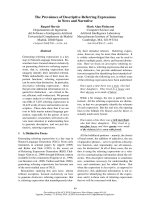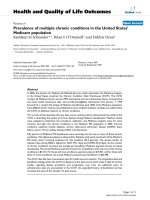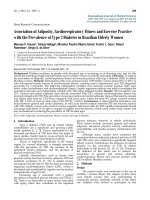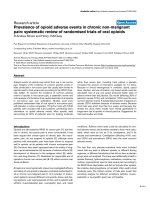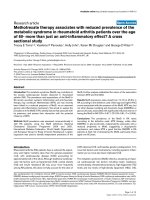prevalence of beta lactam allergy a retrospective chart review of drug allergy assessment in a predominantly pediatric population
Bạn đang xem bản rút gọn của tài liệu. Xem và tải ngay bản đầy đủ của tài liệu tại đây (1.02 MB, 6 trang )
Abrams et al.
Allergy Asthma Clin Immunol (2016) 12:59
DOI 10.1186/s13223-016-0165-6
Allergy, Asthma & Clinical Immunology
Open Access
RESEARCH
Prevalence of beta‑lactam allergy:
a retrospective chart review of drug allergy
assessment in a predominantly pediatric
population
Elissa M. Abrams1, Andrew Wakeman2, Tom V. Gerstner1, Richard J. Warrington3 and Alexander G. Singer4*
Abstract
Background: Research suggests that 90% of patients labeled beta-lactam allergic are able to tolerate penicillins following further assessment. This study aims to define and describe the frequency of true beta-lactam allergy following
allergy patient evaluation in a predominantly pediatric population.
Methods: 306 primary care patients referred between January 2010 and June 2015 were assessed for a suspected
beta-lactam allergy. Patient demographics, history and test results were extracted from electronic medical records.
Testing performed was based on specialist recommendation following review of patient history.
Results: 34% of the study participants had intradermal testing. Oral challenge was given to 96.7% of the sample. 96%
of patients with a prior history of beta-lactam allergy were advised that they could re-introduce beta-lactam antibiotics following evaluation.
Conclusions: Among patients with a documented beta-lactam allergy or a recent history of a reaction there is a low
rate of ‘true’ beta-lactam allergy. Consistent evaluation of beta-lactam antibiotic allergies can reduce rates of broad
spectrum antibiotic prescribing, among other harmful consequences.
Keywords: Anaphylaxis, Beta-lactam allergy, Drug allergy, adverse drug reaction
Background
Approximately 10–20% of the general population have
been labeled as penicillin allergic [1–3]. However, studies
have clearly documented that over 90% of patients labeled
allergic are able to tolerate penicillins once assessed [2,
4]. In addition, recent estimates suggest that the rate of
penicillin allergy may be decreasing [5], particularly in
pediatric populations [6]. This may be due to the changing nature of antibiotic prescription patterns. The reduction in intravenous penicillin use and the increase in oral
amoxicillin usage may have reduced true allergies while
increasing likelihood of viral rashes being inappropriately
*Correspondence:
4
Department of Family Medicine, University of Manitoba, Winnipeg,
Canada
Full list of author information is available at the end of the article
defined as “allergies” [6]. In addition, up to 80% of true
IgE allergic patients will lose their sensitivity over time
[7, 8], further contributing to reductions in penicillin
allergy rates. For example, in a study of 740 patients with
a history of beta-lactam antibiotic reactions, prevalence
of positive skin testing was related to time elapsed since
clinical reaction, in cases that reacted, 93% had a positive skin test in the past year, while this rate dropped to
22% in those who were evaluated 10 years or more after
a reaction [8].
In 2015, the American Academy of Allergy Asthma
and Immunology (AAAAI) released a statement requesting urgent action on the specified harms of erroneously
labeling patients with penicillin allergy [9]. In particular, patients reporting penicillin allergies are more likely
to receive broad-spectrum antibiotics [10] which have
been linked to higher rates of antibiotic resistance [11]
© The Author(s) 2016. This article is distributed under the terms of the Creative Commons Attribution 4.0 International License
( which permits unrestricted use, distribution, and reproduction in any medium,
provided you give appropriate credit to the original author(s) and the source, provide a link to the Creative Commons license,
and indicate if changes were made. The Creative Commons Public Domain Dedication waiver ( />publicdomain/zero/1.0/) applies to the data made available in this article, unless otherwise stated.
Abrams et al. Allergy Asthma Clin Immunol (2016) 12:59
and higher health care costs in the community [12] and
hospital [13]. Furthermore, while the causation remains
to be elucidated, penicillin allergies recorded in hospital
Electronic Health Records correlate strongly with longer
stays and more iatrogenic infections [14]. While aiming
to protect patients from adverse drug reactions, inappropriately using conservative documentation of penicillin
allergy confers direct patient harm and is an unnecessary
cost to the healthcare system [9–14].
This study aims to define and describe the frequency of
true penicillin allergy among primary care patients evaluated by Allergy and Immunology specialists. It attempts
to determine whether penicillin allergy could be removed
from patient charts, to avoid the negative consequences
of that labelling.
Methods
Study design
This retrospective chart review includes 306 predominantly pediatric patients referred from community primary care providers (family physicians or pediatricians)
to assess a suspected allergy to beta-lactam antibiotics
by two participating allergy and immunology specialists
in Winnipeg, Manitoba, Canada. The outcome measures
used were based on the recommendations made by the
two participating allergy specialists, both fellows of the
Royal College of Physicians of Canada. Consultations are
publicly funded by Manitoba Health with no direct cost
to the patient.
The inclusion criterion included all patients with a consultation regarding suspected beta-lactam allergy from
January 2010 to June 2015. Patients were excluded if they
had incomplete follow-up or were not evaluated for betalactam allergy in the clinic. In addition, intradermal testing and oral challenge were delayed at least 6 weeks after
a clinical reaction.
Approval was obtained from the Human Research Ethics Board of the University of Manitoba. Individual participant consent was not obtained in accordance with
Canada’s Tri-Council Policy Statement: Ethical Conduct
for Research Involving Humans and the University of
Manitoba Research Ethics board policy regarding retrospective chart reviews.
Patient data was extracted from electronic medical
records (JonokeMed 5.5.3) and collated into a spreadsheet profiling patient age, gender, history and symptoms
of adverse drug reactions, test results, and consultant recommendations. Queries captured patients with
a visit to a participating physician between January 1,
2010 to July 2015. Data was collected in July 2015 by a
single study author and validated by the consultants
for accuracy. Patients were selected if they had either a
visit coded with ICD9 code 995.20 for a drug allergy or a
Page 2 of 6
billing (fee) tariff corresponding to administration of an
oral provocation challenge. Documentation from patient
visits were reviewed for key terms “icil” or “amox” in the
context of a reaction history or allergy test. All patient
charts underwent a review for a referral and consultation
regarding beta-lactam allergy. Relevant chart information
was extracted from notes relating to initial and follow-up
appointments.
The recommendations made by the consultants were
primarily based on results from beta-lactam allergy
testing, performed by protocols laid out by the American Academy of Allergy, Asthma and Immunology [2].
Those with recent adverse drug reaction (ADR) histories of non-urticarial rash and pruritus were orally challenged with appropriate dosing of amoxicillin or other
implicated beta-lactam antibiotic [15]. Patients having
remote or vague histories and those with histories more
suggestive of a type I reaction received intradermal testing with later oral drug provocation challenge to the
implicated beta-lactam antibiotic, if intradermal testing
was negative. Intradermal testing was done with standard concentrations of penicilloyl polylysine (6 × 10−5 M),
benzylpenicillin (10,000 U/mL) and ampicillin (1.25 mg/
mL). Intradermal testing was read 15 min after administration. Delayed intradermal testing was not done, however patients were instructed to contact the clinic should
any late reactions occur. Patients with histories suggestive
of serious delayed-type reactions such as serum sickness
or Stevens-Johnson were not tested and recommended to
avoid beta-lactam antibiotics.
Results
There were 335 unique patient records meeting the study
criteria. A total of 29 patients were excluded from the
study due to pending test results (25 patients), refusal of
oral challenge (3 patients) and a history of chronic urticaria with incomplete testing (1 patient). A total of 306
patients were considered as part of the study. Figure 1
displays the study inclusion criteria.
Study population
303 (99%) of the patients were referred by their primary
care providers (family physicians, pediatricians or nurse
practitioner) the remainder were referred by an Emergency Department or other specialist providers. The
sample was evenly distributed between the genders,
with males being slightly younger on average at testing
(Table 1). The mean age of the patient population was
11.6 years (standard deviation 17.3 years) and the median
age was 6.0 years. Our sample was mostly pediatric
patients although the large standard deviation reflects a
small number of adult and older patients who skew the
distribution to a bimodal pattern.
Abrams et al. Allergy Asthma Clin Immunol (2016) 12:59
Page 3 of 6
Fig. 1 Inclusion criteria
Table 1 Patient demographics
Total
Male
Female
Number
306 (100%)
150 (49%)
156 (51%)
Age (Mean, SD)
11.6, 17.3
9.5, 16.3
13.6, 18.0
(Mode)
1
2
3
(Q1, Q2, Q3)
3, 6, 11
2, 5, 10
3, 7, 14
(Extremes)
0, 89
0, 89
0, 82
Patients had a variety of clinical reactions upon betalactam antibiotic exposure with the most prevalent “nonurticarial skin reactions”, “Urticarial skin reactions” and
“multi-systemic complaints”. Table 2 outlines patient
clinical reactions. Average time elapsed between drug
reaction and allergological work up was 5.4 years. A total
of 106 patients (34%) had intradermal testing (see Fig. 2).
Oral challenge was given to 96.7% of the sample (296
patients), 64.5% (191 patients) of those patients had a
history inconsistent with type 1 allergy and therefore did
not receive prior skin testing. Type 1 allergy was found
among 0.7% of the sample: 0.3% (1 patient) had a positive intradermal test and 0.3% (1 patient) with a negative
intradermal test had a positive oral challenge potentially consistent with a type 1 reaction. This reaction
(acute onset abdominal pain and emesis within an hour
of a dose of amoxicillin) was different than the reaction
that this patient initially presented with (acute urticaria
within one hour after a dose of amoxicillin), and occurred
in a toddler.
Additionally, 1.3% of the sample (4 patients) had a
positive delayed oral challenge (delayed maculo-papular
Abrams et al. Allergy Asthma Clin Immunol (2016) 12:59
Page 4 of 6
Table
2 Clinical reaction upon beta-lactam antibiotic
exposure
Reaction
Number of patients
GI complaints
2
Unknown skin reaction (remote Hx)
18
Non-urticarial skin reactions
151
Urticarial skin reactions
76
Skin peeling noted
2
Multi-systemic complaints
50
Skin rash with fever/malaise
5
Describing open sores
1
Skin rash with GI complaints
6
Edema or difficulty breathing
34
Myalgia or joint swelling
5
History unknown
8
Fig. 2 Patient evaluation
exanthems) after negative intradermal testing. In addition, 1.9% (6 patients) were advised to avoid beta-lactams
without testing based on a clinical history suggestive of a
serious delayed reaction (Table 3).
After completed consultation, 2/306 patients (0.7%,
CI95 0–2.6%) were considered to be at increased risk
of future IgE-mediated reactions (one due to positive
intradermal testing and one due to a reaction with oral
Table 3 Allergy type
Consensus allergy
Number
Percent (%)
Type 1
2
0.7
Type 2
0
–
CI95 (%)
0–2.6
–
Type 3 (serum sickness)
5
1.6
0.5–3.9
Type 4 (mild)
4
1.3
0.3–3.5
Type 4 (SJS)
1
0.3
0–2.1
challenge). In addition, 10 patients (3.3%, CI95 1.7–6.0%)
were considered to be at increased risk of delayed reactions (4 of whom had delayed maculopapular exanthems
with oral challenge, and 6 of whom had no testing due
to history suggestive of a serious delayed reaction such
as serum sickness). Overall, 294 (96.1%, CI95 93.2–97.9%)
of those evaluated were advised that they could safely
use beta-lactam antibiotics in the future. It is unknown
whether these patients have used beta-lactam antibiotics
since their allergy evaluation.
Discussion
This current study found that among patients with a
label of beta-lactam allergy there was a low rate of true
allergy observed. The overall rate of false positive reports
of penicillin allergy was high with 96.1% of patients with
a prior history of beta-lactam allergy advised that they
could safely re-introduce beta-lactam antibiotics. The
rate of true penicillin allergy in this sample was much
lower than in other studies of referral populations, which
have documented 10–20% true allergy among patients
labeled as beta-lactam allergic [1–3]. Consistent evaluation of patients with a history of beta-lactam allergy
could reduce the use of broad-spectrum antibiotics if
performed before labelling patients with a presumed
allergy. This practice could significantly reduce the risk of
patients receiving broad spectrum antibiotics inappropriately, which is thought to contribute to antibiotic resistance. The Centers for Disease Control and Prevention
report that in the United States there are about 2 million
illnesses and 23,000 deaths caused by antibiotic-resistant
bacteria [16]. The AAAAI has urged more aggressive use
of drug allergy testing to reduce increasing rates of antibiotic resistance [9].
Previous studies have reported that 9–11% of patients
have systemic reactions when skin testing is performed
to beta-lactams [17, 18]. In a recent study 2.6% of betalactam allergic children reported mild to moderate reactions to skin testing [19]. Our study, in contrast, noted no
systemic reactions to skin testing (although several possible explanations could exist for this finding).
In the current study, no patient with negative intradermal testing had a subsequent anaphylactic reaction on
oral challenge. One patient had emesis and abdominal
pain, which was considered to be potentially indicative of
a type I reaction as it was shortly following oral challenge
in a toddler. In addition, 1.3% (4 patients) had a delayed
reaction on oral challenge, despite negative intradermal
testing.
A possible limitation of our study was the lack of
delayed intradermal readings and use of patch testing. For delayed beta-lactam reactions, some studies have suggested that either or both of these methods
Abrams et al. Allergy Asthma Clin Immunol (2016) 12:59
may provide some value [20–22]. In fact, some clinical
management reviews recommend delayed intradermal
testing and/or atopy patch testing in the evaluation of
non-immediate reactions to penicillins [20]. Recent studies have also used 5-day drug provocation testing to evaluate non-immediate reactions to amoxicillin [23].
Our study followed the AAAAI practice parameter
which recommends avoidance of testing and oral challenges in patients with a history of severe cutaneous
adverse drug reaction such as serum sickness or Stevens
Johnsons. Interestingly, other studies have noted a low
correlation between reaction history for severe adverse
drug reactions and subsequent risk of reactivity [24].
Low consensus between confirmed beta-lactam allergy
and documented history of a beta-lactam allergy has
implications for the implementation of a national agenda
around interoperable digital patient health records
among health care settings [25]. Interoperability is proposed to improve patient care and outcomes [25] but
could present problems if erroneous clinical information
is being shared due to the lack of patient record accuracy. Health care providers and administrators should be
aware of the risk of sharing potentially erroneous patient
data. These findings suggest the need to more actively
incorporate strategies into primary care practices to
proactively identify patients who are likely mislabeled
with beta-lactam allergy to avoid the harms of antibiotic
avoidance.
This study tracked consultation recommendations as
oppose to more objective test results which was expected
to produce a more reliable measure of the effects of penicillin allergy consultation in determining rates of valid
avoidance of beta-lactams. Assessing the practices of
only two physicians operating within one clinic can create the potential for bias related to clinical decision making. Our sample is primarily pediatric patients and it may
not apply to other populations without assessment of
local prevalence and demographics of ‘penicillin allergy’.
Furthermore, this sample is dependent on the referral
of primary care physicians so it is uncertain if certain
patient populations with greater or lesser risk of mislabeling are being referred or not.
Conclusion
Our findings demonstrate that a profound majority of
pediatric patients in the community who had a consultation with an allergist erroneously consider themselves
allergic prior to evaluation. Meanwhile, the risks of avoiding these targeted and often effective antibiotics have
severe consequences for patients and the population.
More research is needed to evaluate the prevalence of
potential mislabeling of beta-lactam “allergy” and determine the true rate of type 1 reaction in the population.
Page 5 of 6
Information regarding allergies that become part of
patient records are primarily self-reported. As patients
have increasing health literacy, more discussion will
be required to clarify these labels. In addition, primary
care providers need to be better informed as to when to
refer patients for consultation with an allergist and how
to properly record drug reactions. These types of initiatives are increasingly important as health information is
shared across the system in systems that will eventually
be interoperable.
This study highlights the widespread mislabeling of primary care patients with beta-lactam antibiotic allergy in a
predominantly pediatric population and suggests urgent
attention be paid to identifying these patients in order to
determine who are truly allergic.
Abbreviations
AAAAI: American Academy of Allergy Asthma and Immunology; ADR: adverse
drug reaction; SJS: Stevens Johnson Syndrome.
Authors’ contributions
AW performed the chart abstractions, and compiled the database and the
initial analysis. EA, AS, AW and TG wrote the manuscript. RW reviewed and
contributed substantially to the manuscript content. Both EA and TG assessed
the patients in this study and worked together on study design. All authors
read and approved the final manuscript.
Author details
1
Section of Allergy and Immunology, Department of Pediatrics and Child
Health, University of Manitoba, Winnipeg, Canada. 2 University College Dublin,
Dublin, Ireland. 3 Section of Allergy and Immunology, Department of Internal
Medicine, University of Manitoba, Winnipeg, Canada. 4 Department of Family
Medicine, University of Manitoba, Winnipeg, Canada.
Acknowledgements
LK for her editing and formatting of the manuscript. RS for assistance with
data extraction. TB, RCF, and DG for assistance with patient evaluation and
care. UCD summer student research program, and Department of Family
Medicine at the University of Manitoba.
Competing interests
The authors declare that they have no competing interests.
Availability of data and materials
Data supporting the article is found in a database compiled by A. Wakeman.
Ethics approval and consent to participate
Consent was obtained through University of Manitoba Health Research Ethics
Board H2015:280 (HS18832).
Received: 3 August 2016 Accepted: 31 October 2016
References
1. Macy E, Ngor EW. Safely diagnosing clinically significant penicillin allergy
using only penicilloyl-poly-lysine, penicillin, and oral amoxicillin. J Allergy
Clin Immunol Pract. 2013;1(3):258–63. doi:10.1016/j.jaip.2013.02.002.
2. Joint Task Force on Practice Parameters. American Academy of Allergy,
Asthma and Immunology; American College of Allergy, Asthma and
Immunology; Joint Council of Allergy, Asthma and Immunology. Drug
allergy: an updated practice parameter. Ann Allergy Asthma Immunol.
2010;105(4):259–73. doi:10.1016/j.anai.2010.08.002.
Abrams et al. Allergy Asthma Clin Immunol (2016) 12:59
3. Lee CE, Zembower TR, Fotis MA, et al. The incidence of antimicrobial
allergies in hospitalized patients: implications regarding prescribing patterns and emerging bacterial resistance. Arch Intern Med.
2000;160(18):2819–22.
4. Borch JE, Andersen KE, Bindslev-Jensen C. The prevalence of suspected
and challenge-verified penicillin allergy in a university hospital population. Basic Clin Pharmacol Toxicol. 2006;98(4):357–62.
5. Macy E, Schatz M, Lin C, Poon KY. The falling rate of positive penicillin skin
tests from 1995 to 2007. Perm J. 2009;13(2):12–8.
6. Jost BC, Wedner HJ, Bloomberg GR. Elective penicillin skin testing in a pediatric outpatient setting. Ann Allergy Asthma Immunol.
2006;97(6):807–12.
7. Blanca M, Torres MJ, García JJ, et al. Natural evolution of skin test sensitivity in patients allergic to beta-lactam antibiotics. J Allergy Clin Immun.
1999;103(5 Pt 1):918–24.
8. Sullivan TJ, Wedner HJ, Shatz GS, Yecies LD, Parker CW. Skin testing to
detect penicillin allergy. J Allergy Clin Immunol. 1981;68(3):171–80.
9. American Academy of Allergy Asthma & Immunology. Antibiotic Stewardship: the need for penicillin allergy testing. 2015. ai.
org/Aaaai/media/MembersMedia/Member%20Secure%20Files/Advocacy/Pencillin-Allergy-brief-statement.pdf.
10. Solensky R, Earl HS, Gruchalla RS. Clinical approach to penicillin-allergic
patients: a survey. Ann Allergy Asthma Immun. 2000;84(3):329–33.
11. Goossens H, Ferech M, Vander Stichele R, Elseviers M, Project Group ESAC.
Outpatient antibiotic use in Europe and association with resistance: a
cross-national database study. Lancet. 2005;365(9459):579–87.
12. Macy E. Elective penicillin skin testing and amoxicillin challenge: effect
on outpatient antibiotic use, cost, and clinical outcomes. J Allergy Clin
Immunol. 1998;102(2):281–5.
13. Rimawi RH, Cook PP, Gooch M, et al. The impact of penicillin skin testing on clinical practice and antimicrobial stewardship. J Hosp Med.
2013;8(6):341–5. doi:10.1002/jhm.2036.
14. Macy E, Contreras R. Health care use and serious infection prevalence
associated with penicillin “allergy” in hospitalized patients: a cohort
study. J Allergy Clin Immunol. 2014;133(3):790–6. doi:10.1016/j.
jaci.2013.09.021.
Page 6 of 6
15. Caubet J, Kaiser L, Lemaitre B, Fellay B, Gervaix A, Eigenmann P. The role
of penicillin in benign skin rashes in childhood: a prospective study
based on drug rechallenge. J Allergy Clin Immun. 2011;127(1):218–22.
doi:10.1016/j.jaci.2010.08.025.
16. Centers for disease control and prevention [Internet]. Antibiotic/Antimicrobial Resistance. 2016. Accessed
17 May 2016.
17. Co Minh H, Bousquet P, Fontaine C, Kvedariene V, Demoly P. Systemic
reactions during skin tests with beta-lactams: a risk factor analysis. J
Allergy Clin Immun. 2006;177:466–8.
18. Torres MJ, Romano A, Mayorga C, et al. Diagnostic evaluation of a large
group of patients with immediate allergy to penicillins: the role of skin
testing. Allergy. 2001;56:850–6.
19. Ponvert C, Perrin Y, Bados-Albiero A, et al. Allergy to betalactam antibiotics in children: results of a 20 year study based on clinical history, skin
tests, and challenge tests. Pediatr Allergy Immunol. 2011;22(4):411–8.
20. Romano A, Caubet JC. Antibiotic allergies in children and adults: from
clinical symptoms to skin testing diagnosis. J Allergy Clin Imunol Pract.
2014;2:3–12.
21. Romano A, Viola M, Mondino C, et al. Diagnosing nonimmediate
reactions to penicillins by in vivo tests. Int Arch Allergy Immunol.
2002;129:169–74.
22. Romano A, Quarantino D, Di Fonso M, et al. A diagnostic protocol for
evaluating nonimmediate reactions to aminopenicillins. J Allergy Clin
Immunol. 1999;103:1186–90.
23. Mori F, Cianferoni A, Barni S, Pucci N, Rossi ME, Novembre E. Amoxicillin
allergy in children: five-day drug provocation test in the diagnosis of
nonimmediate reactions. J Allergy Clin Immun. 2015;3(2):375–80.
24. Ponvert C, Weilenmann C, Wassenberg J, et al. Allergy to betalactam
antibiotics in children: a prospective follow-up in retreated children after
negative responses in skin and challenge tests. Allergy. 2007;62:42–6.
25. Canada Health Infoway [Internet]. Canada. Accelerating clinical interoperability in Canada: the path forward. 2014. oway-inforoute.
ca/en/component/edocman/2329-accelerating-clinical-interoperabilityin-canada-the-path-forward-2/view-document?Itemid=101. Accessed
17 May 2016.
Submit your next manuscript to BioMed Central
and we will help you at every step:
• We accept pre-submission inquiries
• Our selector tool helps you to find the most relevant journal
• We provide round the clock customer support
• Convenient online submission
• Thorough peer review
• Inclusion in PubMed and all major indexing services
• Maximum visibility for your research
Submit your manuscript at
www.biomedcentral.com/submit
